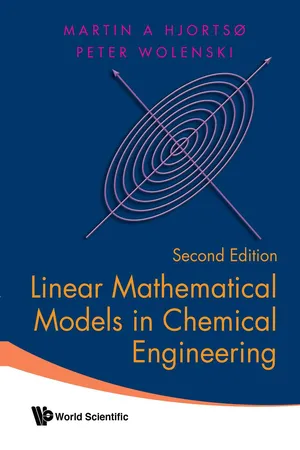![]()
Chapter 1
Model Formulation
Engineers write mathematical models for numerous reasons. To design processes, to scale them up or down, to optimize process performance and financial gain, to minimize formation and release of undesirable or hazardous compounds, to design control strategies and so on. There hardly seems a need to justify why engineers need to learn some mathematics and develop the basic skills needed for writing mathematical models.
Writing mathematical models falls into the class of dreaded “word problems” and is not an art by a skill that can be acquired by practising writing models for increasingly complex systems. Engineering models are not true or false in the sense that fundamental laws of nature are true or false. Engineering models are good or they are bad. Good engineering models accurately reflect, within measurement error, the process being modelled over the relevant range of operating conditions. Good models are mechanistic in the sense that they are based on established physics and chemistry, are as simple as possible in that they only incorporate mechanisms that are significant for the system being modelled and have only a small number of model parameters. Bad models on the other hand use ad-hoc assumptions, are unnecessarily complex by incorporating a smattering of mechanisms without any regard for whether or not these are important and have “too many” model parameters. It is often possible to devise several different models of the same physical reality and one can pick and choose among these depending on the desired model accuracy, the purpose of the model and on the ease of model analysis.
Suppose we want to develop a model of the number of students in a classroom. It is a good idea to start by specifying the nomenclature that will be used when writing the model. Let N(t) be the number of students in the classroom at time t, then
This ridiculously simple model is an example of an initial value problem; an initial value, the value of N(t0), must be specified to solve the problem. In spite of its simplicity, the model encompasses three concepts that are common to all models we will consider in this book. The three concepts are the idea of a conserved property, a control volume and transport across the control volume surface.
The conserved property in this model is the number of students. The number of students in the classroom may change but only through known processes, by students entering and exiting the room. Students do not appear or vanish into thin air spontaneously. It is this property that allows us to write a conservation balance on the number of students. Conservation balances can be written only on conserved properties such as mass, moles, energy, number of particles, etc. These are called extensive properties, physical properties that are additive and depend on the size of the system. One cannot write conservation balances on properties such as temperature, concentration, pressure, density, etc. These are intensive properties or bulk properties that are independent of the size of the system and not additive when systems are joined together.
A conservation balance is always written over a control volume (CV), the classroom in this example. The CV over which a balance equation is written is defined by its surface and the conservation balance above states that the number of students in the room change depending on how many students cross the CV surface and whether they leave or enter the CV. The term is slightly misleading because the CV may not be a volume in physical space and the size of the CV may therefore not have units of length cubed. For instance, in the case of the classroom, it would be more reasonable to measure the size of the room as floor area. The size of a CV may also change with time. For instance, the combustion engine of an ordinary car can be modelled as a chemical reactor that repeatedly expands and contracts as fuel is added, combusted and expelled. The engine works by virtue of the fact the physical volume of the CV changes with time.
The students entering and exiting the room represent a rate of transport across the CV surface and to complete the model one must have some way of modelling this rate of transport. In most chemical engineering applications, the rates of transport are given by either the flow rates and compositions of process streams or by constitutive equations such as Fourier’s law of conduction (for energy balances), Fick’s law (for mass or mole balances) or Newton’s law of viscosity (for momentum balances). Constitutive equations are not fundamental laws of nature, but rather expression or models based on empirical observations or more fundamental models such as models of molecular dynamics. The modeller may have available a large number of possible constitutive equations that can describe a given rate of transport. Unless there are substantial reasons for doing otherwise, the best choice is usually to pick a linear constitutive equation since this will give the simplest mathematical model. For instance, if one does not know a priori that a fluid is non-Newtonian, then one should use Newton’s law of viscosity rather than the power law model in a momentum balance.
It is important to be mindful of the fact that the constitutive equations mentioned above, ...

